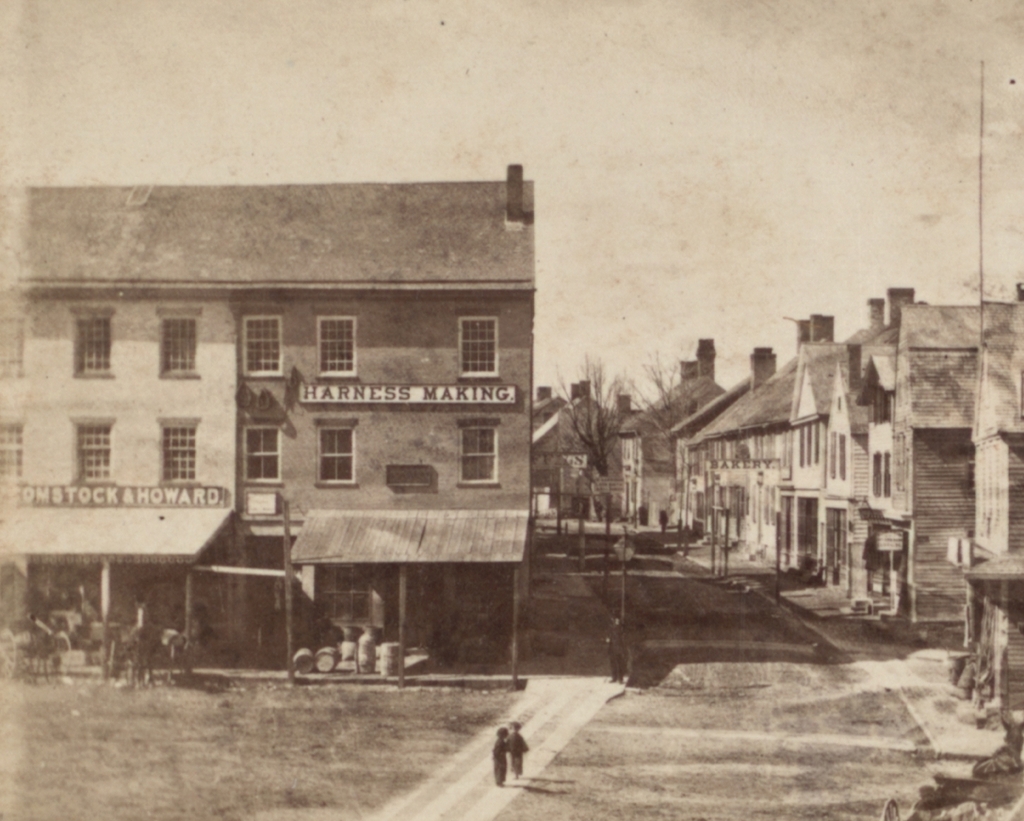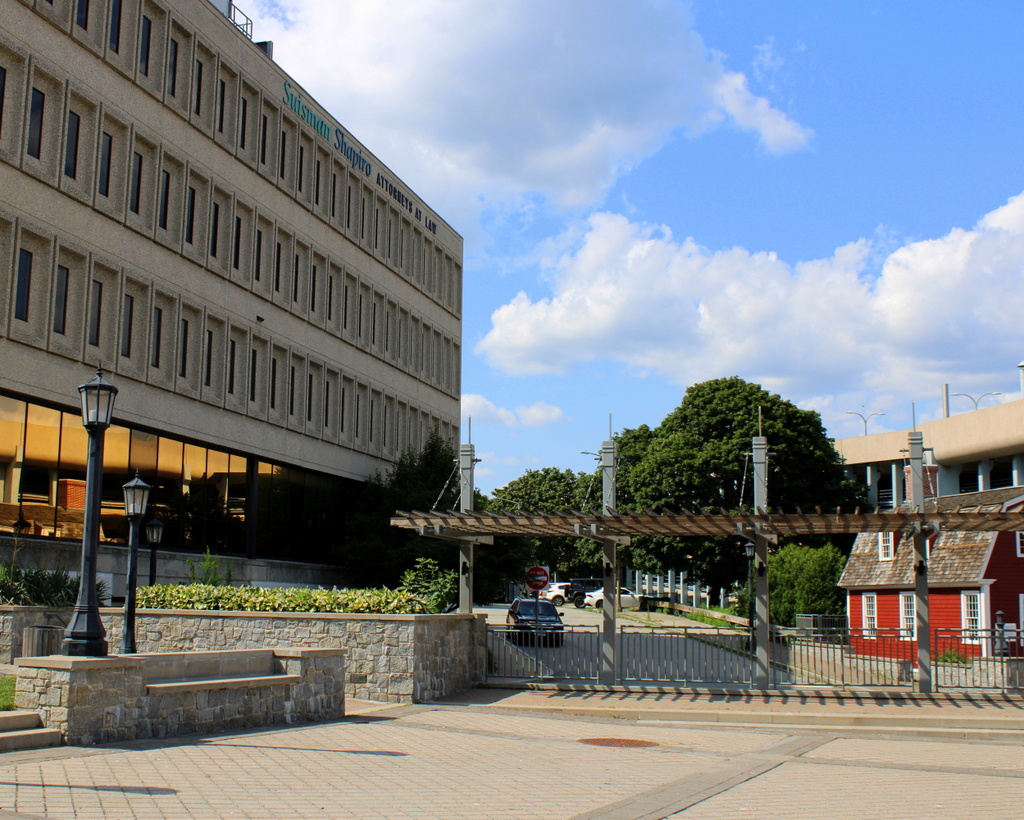The view looking north on Bradley Street from the corner of State Street in New London, around 1868. Image courtesy of the New York Public Library.
The scene in 2021:
During the 1800s, New London was an important seaport, in particular because of its role in the whaling industry. At one point, it was second only to New Bedford in terms of number of whaling ships, which brought significant prosperity to the city. However, like other major ports, New London also had its share of crime, poverty, and vice, and perhaps no street in the city better exemplified this than Bradley Street, which is shown in the first photo around 1868.
At the time, Bradley Street began here at State Street, and it ran northward parallel to Main Street for three blocks, before ending at Federal Street. The northern end of the street was predominantly residential, but the southern end, shown here in this scene, had an assortment of commercial buildings, mostly older wood-frame structures.
There are a few signs that are visible in the first photo, advertising for businesses such as a harness maker at the corner of State Street and a bakery further down Bradley Street. However, the street was better known for its less reputable establishments, particularly its saloons and brothels. As early as the 1840s, women were convicted for running “houses of ill fame” here on Bradley Street, and the street would remain the epicenter of the city’s red light district into the early 20th century. Even Eugene O’Neill, the prominent playwright, would patronize these brothels as a young man while spending summers with his family in New London, and he made reference to one of the madams, “Mamie Burns,” in his famous play Long Day’s Journey into Night.
By the turn of the 20th century, when O’Neill would have made his visits to Bradley Street, the street was predominantly the home of working class immigrants, particularly Polish and Jewish families. However, the relatively short street also had up to 13 saloons and four brothels in operation by 1910, as outlined by Dr. Matthew Berger in a 2021 blog post.
In an effort to overcome the street’s seedy reputation, it was eventually rebranded as North Bank Street around 1921. Then, around the 1960s it became Atlantic Street, and it was about this same time that all of the older buildings on the street were demolished as part of an urban renewal project. The street was also truncated so that it now ends after just one block, rather than continuing all the way to Federal Street. The result is a streetscape that looks more or less like every other urban renewal project of the 1960s, with a parking garage on one side and a vaguely brutalist office building on the other side.
However, there is one historic building that stands in the present-day scene. On the far right side in the foreground is the Nathan Hale Schoolhouse. It was built in 1773, and the famous Revolutionary War hero taught here from 1774 to 1775. This is not its original location, though. It has been moved six times over the past 250 years, most recently in 2009 when it was brought to its current location at the corner of what had once been Bradley Street.



Thank you, Derek, for linking to my essay! 🙂
This essay is actually the third in a series, the first being: https://justbearwithme.blog/2021/10/11/the-burns-woman-nells-grandfather-statutory-rape-and-eugene-oneill/
Long story short, my wife is Eleanor “Nell” Broley. Her paternal grandfather is Clarence Henry Broley. In 1909, he was married to his first wife: Adelaide “Addie” Burns. She ran a brothel on Bradley Street – and is the inspiration for the woman Eugene O’Neill calls “Mamie Burns” in LONG DAY’S JOURNEY INTO NIGHT. (“Fat Violet” is based upon Addie’s housekeeper Viney Maladay, who later had her own brothel.)
In January 1907, a 15-year-old girl from New Haven named Mae Burns was either enticed to Addie’s place – or went voluntarily. Either way, Mae – who was no innocent – had sex with two unidentified men for money, sharing in the proceeds. Under CT law at the time, though, Addie, as brothel owner, could be charged with statutory rape. Arrested in January 1909, she was convicted after a short travesty of a trial. This was despite character testimony from her husband Clarence, whom she had set up in the hotel/saloon business in Providence, RI. Sentenced to an absurd 20 years, she served “only” 9 1/2 years in Wethersfield.
The trial judge was a former crusading Mayor of New London, who clearly wanted to make an example of Addie Burns. So much so, I wrote a follow-up essay in which I suggest I will write a book framing the trial within the larger social context: women who lost financially-supportive men in the Civil War and turned to prostitution to survive, anti-immigrant sentiment, Congregationalist white male Yale grads vs. well, everybody else. 🙂
Nell is also considering a work of historical fiction based upon the case. There are just so many fascinating cross-currents on such a tiny street.
Anyway, thank you again!
It is definitely an interesting story, and thank you for sharing your detailed research on the street. It was very helpful in writing this post! At the outset I figured this would be a fairly straightforward then-and-now scene of old buildings contrasted with modern urban renewal. But then I came across your post and ended up on a rabbit trail!
Sad that you point out a small street of I’ll dispute with a 60’s era bldg when New London has a ton of Historic Bldgs and history.
Wondering where Potter st was located back then? … what street is it now?